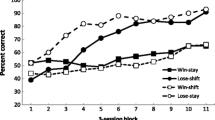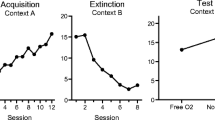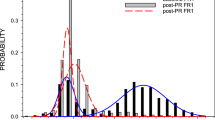Abstract
The experiment used 63 albino rats trained in controlled-operant bar-pressing boxes. The design was a 3 × 3 factorial in which 3 levels of sucrose concentration (4%, 16%, and 64%) were combined with 3 levels of volume (.05, .15, and .45 ml.). The major findings were (a) acquisition performance was an increasing monotonic function of both volume and concentration, (b) volume and concentration interacted with the effects of volume being greatest at low level of concentration, and (c) in extinction only concentration affected performance, with the 4% groups showing poorer performance in early trials.
Similar content being viewed by others
References
AMSEL, A. 1958. The role of frustrative nonreward in noncontinuous reward situation. Psychological Bulletin, 55, 102–119.
BLACK, R. W. 1965. Discrimination learning as a function of varying pairs of sucrose rewards. Journal of Experimental Psychology, 70, 452–458.
COLLIER, G. 1959. The loci of reinforcement. American Psychologist, 14, 398.
COLLIER, G., KNARR, F. A., & MARX, M. H. 1961. Some relations between the intensive properties of the consummatory response and reinforcement. Jour-nal of Experimental Psychology, 62, 484–495.
COLLIER, G., & MYERS, L. 1961. The loci of reinforcement. Journal of Experimental Psychology, 61, 57–66.
COLLIER, G., & SISKEL, M., Jr. 1959. Performance as a joint function of amount of reinforcement and interreinforcement interval. Journal of Experimental Psychology, 57, 115–120.
COLLIER, G., VOGEL, J., & REGA, F. 1966. Two-bar sucrose preference. Psychonomie Science, 6, 203–204.
COLLIER, G., & WILLIS, F. N. 1961. Deprivation and reinforcement. Journal of Experimental Psychology, 62, 377–384.
GUTTMAN, N. 1953. Operant conditioning, extinction, and periodic reinforcement in relation to concentration of sucrose used as a reinforcing agent. Journal of Experimental Psychology, 46, 213–224.
GUTTMAN, N. 1954. Equal-reinforcement values for sucrose and glucose solutions compared with equal-sweetness values. Journal of Comparative and Physiological Psychology, 47, 358–361.
HUTT, F. J. 1954. Rate of barpress as a function of quality and quantity of food reward. Journal of Comparative and Physiological Psychology, 47, 235–239.
ISON, J. R., & ROSEN, A. J. 1968. Extinction and reacquisition performance as a function of sucrose-solution rewards and numbers of acquisition trials. Psychological Reports, 22, 375–379.
KNARR, F. A., & COLLIER, G. 1962. Taste and consummatory activity in amount and gradient of reinforcement functions. Journal of Experimental Psychology, 63, 579–588.
MARX, M. H., & PIEPER, W. A. 1962. Acquisition of instrumental response as a function of incentive contrast. Psychological Reports, 10, 635–638.
MARX, M. H., & PIEPER, W. A. 1963. Instrumental acquisition and performance on fixed-interval reinforcement as a function of incentive contrast. Psychological Reports, 12, 255–258.
MARX, M. H., TOMBAUGH, J. W., COLE, C, & DOUGHERTY, D. 1963. Persistence of nonreinforced responding as a function of the direction of a prior ordered incentive shift. Journal of Experimental Psychology, 66, 542–546.
MARX, M. H., TOMBAUGH, T. N., HATCH, R. S., & TOMBAUGH, J. W. 1965. Controlled operant boxes with discrete-trial programming for multiple experimental use. Perceptual and Motor Skills, 21, 247–254.
PUBOLS, B. H. 1960. Incentive magnitude, learning, and performance in animals. Psychological Bulletin, 57, 89–115.
SCHAEFFER, R. W., & HANNA, B. 1966. Effects of quality and quantity of reinforcement upon response rate in acquisition and extinction. Psychological Reports, 18, 819–829.
SPERLING, S. E. 1965. Reversal learning and resistance to extinction: A review of the rat literature. Psychological Bulletin, 63, 281–297.
STEBBENS, W. C., MEAD, P. B., & MARTIN, J. M. 1959. The relation of amount of reinforcement to performance under fixed-interval schedule. Journal of the Experimental Analysis of Behavior, 2, 351–355.
TOMBAUGH, T. N., & MARX, M. H. 1965. Effects of ordered and constant sucrose concentrations on nonreinforced performance. Journal of Experimental Psychology, 69, 630–636.
UHL, C. N., & YOUNG, A. G. 1967. Resistance to extinction as a function of incentive, percentage of reinforcement and number of non-reinforced trials. Journal of Experimental Psychology, 73, 556–564.
Author information
Authors and Affiliations
Additional information
This research was supported in part by Grant GB 5853 from the National Science Foundation, Grant HD 00895 from the National Institute of Child Health and Human Development, and Research Career Award 1-K6-MH-22,023 from the National Institute of Mental Health, to the first author, and by N.R.C. Grant APA 265 to the second author.
Rights and permissions
About this article
Cite this article
Marx, M.H., Tombaugh, T.N. Acquisition and Extinction of an Instrumental Response as a Function of Quality and Quantity of Reinforcement. Psychol Rec 20, 297–303 (1970). https://doi.org/10.1007/BF03393945
Published:
Issue Date:
DOI: https://doi.org/10.1007/BF03393945




